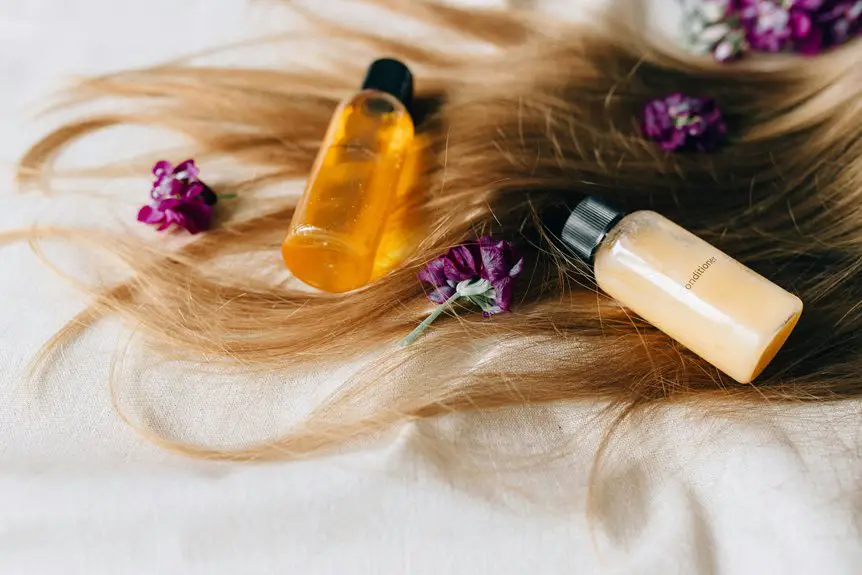To care for clothes that bleed dye, always sort laundry into lights, darks, and whites. Use cold water and gentle cycles to minimize agitation. Add vinegar to the wash to help set colors, and use color-catcher sheets to trap loose dyes. Choose detergents designed for color retention, avoiding bleach. For new items, wash them separately. If you’re dealing with persistent bleeding, consider re-dyeing or follow specific tips that can help keep your clothes vibrant.
Table of Contents
Key Takeaways
- Always wash bleeding clothes separately in cold water to minimize dye transfer to other garments.
- Use gentle detergents designed for color protection, avoiding bleach and harsh chemicals.
- Incorporate color-catcher sheets in your wash to trap loose dyes and prevent color bleeding.
- Turn garments inside out before washing to reduce friction and protect the fabric.
- Consider soaking new or bleeding items in vinegar solution before the first wash to lock in colors.
Understanding the Causes of Dye Bleeding
When you wash new clothes, you might notice that some fabrics bleed dye, leaving your laundry looking less than pristine. This bleeding often occurs due to the type of dye used in the fabric. Certain dyes, especially reactive or direct dyes, can easily release color when exposed to water, particularly in warmer temperatures.
Additionally, the fabric’s composition plays a role; natural fibers like cotton or silk tend to bleed more than synthetic fibers. You may also find that darker colors are more prone to bleeding, especially when the garment is new.
Improper washing techniques, such as using too much detergent or washing in hot water, can exacerbate the issue. Understanding these causes helps you take preventive measures for your laundry.
The Importance of Sorting and Separation
Although you might be tempted to toss all your laundry into one load, sorting and separating clothes is essential to preventing dye bleeding.
Start by dividing your laundry into categories: lights, darks, and whites. This simple step minimizes the risk of darker items bleeding onto lighter fabrics.
Dividing your laundry into lights, darks, and whites is crucial to prevent dye bleeding and protect your clothes.
Pay attention to new clothes, as they’re more likely to bleed dye during their first few washes. If you’ve got items that you suspect may bleed, wash them separately or with similar colors.
Remember, it’s better to do a few smaller loads than risk ruining an entire batch of laundry. By investing time in sorting, you’ll protect your clothes and keep them looking vibrant for longer.
Careful separation is a smart laundry habit!
Using Vinegar for Dye Stability
Using vinegar can be a game-changer for stabilizing dye in your clothes.
Not only does it help seal in colors, but it can also act as a natural fabric softener.
Adding it to your rinse cycle can enhance its effectiveness, keeping your garments looking vibrant longer.
Vinegar’s Dye-Sealing Properties
If you want to enhance the longevity of your colorful garments, consider vinegar for its natural dye-sealing properties.
Vinegar works effectively to help set the dye in your fabrics, reducing the chances of bleeding during washes. To use it, simply mix one cup of white vinegar with a gallon of water, then soak your new garments for about 30 minutes before the first wash.
This process helps lock in the dye, making it less likely to run and stain other items. Remember to rinse the clothes afterward to remove any vinegar smell.
Incorporating this simple step into your laundry routine can save you the hassle of dealing with faded or stained clothing, keeping your favorites looking vibrant longer.
Vinegar as Fabric Softener
While many people think of fabric softeners solely for their ability to soften clothes, vinegar can also serve this purpose while enhancing dye stability. When you add vinegar to your laundry, it helps to keep the colors vibrant and reduces bleeding. This is especially useful for clothes made from fabrics that tend to bleed dye.
Simply mix a cup of white vinegar with your wash cycle, and you’ll notice a difference in both softness and color retention.
Vinegar also works as a natural deodorizer, leaving your clothes smelling fresh. Plus, it’s a cost-effective alternative to commercial fabric softeners, making it a smart choice for both your wardrobe and your wallet.
Rinse Cycle Application
After discovering vinegar’s benefits in the wash cycle, you can take its dye-stabilizing properties a step further during the rinse cycle.
Simply add one cup of white vinegar to your rinse cycle to help set the dye in your clothes. This method not only reduces further bleeding but also keeps your colors vibrant.
If you’re washing multiple items, make sure you use enough vinegar for the load size. You’ll want to avoid using fabric softeners since they can interfere with vinegar’s effectiveness.
After the rinse cycle, hang your clothes to dry, as air drying helps minimize any potential dye transfer.
Careful Washing Techniques to Prevent Bleeding
When washing clothes that bleed dye, always opt for cold water to help maintain their color.
Stick to gentle washing cycles to minimize agitation and prevent excess dye from escaping.
Use Cold Water
Using cold water is one of the simplest yet most effective methods to prevent dye bleeding in your clothes. When you wash items that bleed, hot water can cause the dye to release, leading to unwanted color transfer.
By choosing cold water, you help maintain the integrity of the fabric and keep the colors vibrant. Always check the care label before washing to verify cold water is appropriate for the material. If you’re unsure, it’s safer to err on the side of caution.
You’ll not only preserve your clothes but also save energy. Plus, cold water washing is gentler on your garments, extending their lifespan.
Gentle Washing Cycles
To protect your clothes from dye bleeding, opting for gentle washing cycles is essential. These cycles use slower agitation and shorter wash times, which reduce friction and help preserve the fabric’s integrity.
Always choose a delicate setting on your washing machine, and if possible, wash your items in a mesh laundry bag to further minimize movement.
Avoid overloading the washer, as this can increase agitation and cause more dye to bleed. You’ll also want to keep similar colors together to prevent unwanted transfers.
Finally, skip the spin cycle or use a low-speed option to reduce stress on the fabric. By taking these precautions, you can keep your dyed clothes looking vibrant and new for longer.
Managing Excessive Dye Bleeding
Although some fabrics are more prone to dye bleeding than others, managing excessive dye bleeding is essential to preserving your wardrobe. You can take a few effective steps to minimize color transfer and keep your clothes looking fresh.
- Wash Separately: Always wash bleeding fabrics alone or with similar colors to prevent dye transfer.
- Cold Water Rinse: Use cold water for washing and rinsing, as it helps set dyes and reduce bleeding.
- Color Catcher Sheets: Consider using color catcher sheets in the wash to absorb any loose dye.
- Quick Action: If you notice bleeding, rinse the affected area immediately with cold water to limit damage.
Long-Term Care Strategies for Color Preservation
While it’s important to address immediate dye bleeding issues, long-term care strategies play an essential role in preserving the vibrant colors of your clothes.
Start by washing these items in cold water, as heat can set stains and fade colors. Always turn them inside out before washing to reduce friction and protect the outer layer. Use a gentle detergent specifically designed for color retention, and avoid bleach, which can strip colors.
Dry your clothes away from direct sunlight, as UV rays can cause fading over time. Finally, store them in a cool, dark place to minimize exposure to light and humidity.
The Role of Color-Catcher Sheets
Color-catcher sheets are a handy tool for keeping your laundry vibrant.
They work by absorbing loose dyes in the wash, preventing them from transferring onto other clothes.
How Color-Catcher Sheets Work
How do color-catcher sheets actually prevent dye transfer during laundry? These handy sheets work by absorbing loose dye molecules released from your clothes during the wash cycle. Here’s how they do it:
- Absorption: The sheets contain special polymers that attract and trap the dye, preventing it from settling on other garments.
- Color Binding: They bind to the dye particles, making it less likely for them to reattach to other fabrics.
- Prevention of Bleeding: By capturing excess dye, they minimize the risk of color bleeding onto lighter items.
- Versatility: You can use them with mixed loads, allowing for more flexibility in your laundry routine without worrying about color transfers.
These features make color-catcher sheets essential for maintaining your clothes’ vibrancy.
Benefits of Using Sheets
Using color-catcher sheets in your laundry routine offers several key benefits that can help you maintain your clothes’ appearance and longevity. First, these sheets trap loose dyes that might bleed during washing, preventing color transfer between garments. This means your whites stay bright, and your colors remain vibrant. Second, they can save you time and effort by allowing you to wash mixed loads without worrying about sorting colors.
| Benefits | Description |
|---|---|
| Prevents Color Bleeding | Traps loose dyes to avoid color transfer |
| Enhances Longevity | Protects fabric from fading and discoloration |
| Saves Time | Allows washing of mixed loads without sorting |
Best Practices for Use
When you want to keep your laundry vibrant and free from unwanted dye transfer, incorporating color-catcher sheets into your washing routine is essential.
Here are some best practices to maximize their effectiveness:
- Sort Colors: Always separate darks, lights, and whites before adding your color-catcher sheets for ideal results.
- Follow Package Instructions: Each brand may have specific guidelines; adhere to them for the best protection.
- Use Enough Sheets: Don’t skimp! Using multiple sheets helps absorb more dye, especially in full loads.
- Check After Washing: Inspect your color-catcher sheets after each load. If they’re stained, it’s time to replace them for future washes.
Choosing the Right Detergents
Choosing the right detergent can make all the difference in preserving your clothes that bleed dye. Look for detergents specifically designed for color protection or those labeled as gentle or mild. These products often contain formulas that minimize color transfer and fading.
Avoid using bleach or harsh detergents, as they can exacerbate dye bleeding. Instead, opt for liquid detergents, which typically dissolve better and are less likely to leave residues that can trap dye. You might also consider using a detergent with color-safe properties to help maintain vibrancy.
Be sure to read labels carefully and choose one that suits your washing machine type, whether it’s high-efficiency or standard, to achieve the best results while protecting your garments.
Tips for Washing New or Vibrant Items
To keep your new or vibrant items looking fresh, washing them properly is key. Follow these tips to maintain their color and quality:
- Separate Colors: Always wash dark and bright colors separately from whites or light colors to prevent bleeding.
- Cold Water: Use cold water for washing, as it helps to set the dye and reduces color fading.
- Gentle Cycle: Opt for a gentle cycle to minimize agitation, which can cause dyes to bleed or fabrics to wear out.
- Color Catcher Sheets: Consider using color catcher sheets in the wash. They absorb any loose dyes, protecting your clothes from unwanted staining.
When to Consider Re-Dyeing Fabrics
Re-dyeing fabrics can breathe new life into your wardrobe, especially when colors start to fade or bleed. If you notice significant discoloration or your favorite garment looks worn out, it might be time to reflect on re-dyeing.
Look for items that are still in good shape; damaged or heavily worn textiles won’t yield the best results. Additionally, if you’ve got a piece that bleeds dye during washing, re-dyeing can help unify the color.
Before diving in, assess whether you’re ready for the maintenance that comes with dyed fabrics. If you’re up for it, re-dyeing can transform tired clothes into vibrant, eye-catching favorites that you’ll love to wear again.
Frequently Asked Questions
Can I Use Fabric Softeners With Bleeding Dye Clothes?
You shouldn’t use fabric softeners with clothes that bleed dye. They can create a barrier on the fibers, trapping dye and causing more bleeding. Instead, focus on gentle washing methods to reduce dye transfer.
How Do I Identify if a Fabric Is Prone to Bleeding?
Picture vibrant colors running like a river. To identify bleeding fabrics, check care labels, look for vivid dyes, and perform a simple water test: wet a hidden spot and see if color transfers.
What Should I Do if Dye Bleeding Occurs After Washing?
If dye bleeding occurs after washing, you should immediately rewash the item separately using cold water and a color-safe detergent. Adding a cup of white vinegar can help set the colors and reduce further bleeding.
Are There Any Dyes That Are Less Likely to Bleed?
Yes, certain dyes, like fiber-reactive or natural dyes, tend to bleed less. When shopping, look for garments labeled as colorfast or those treated with special finishes to minimize dye bleeding during washes.
How Can I Protect My Other Clothes From Dye Bleeding?
Think of your closet as a vibrant garden; you wouldn’t let weeds spread. To protect your clothes, wash dyed items separately, use color catchers, and avoid hot water. These steps help keep your wardrobe blooming beautifully.
- Does Chiffon Fabric Stink - July 15, 2025
- Does Chiffon Fabric Affect the Economy - July 15, 2025
- Does Cotton Fabric Have a Nap - July 15, 2025







